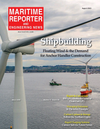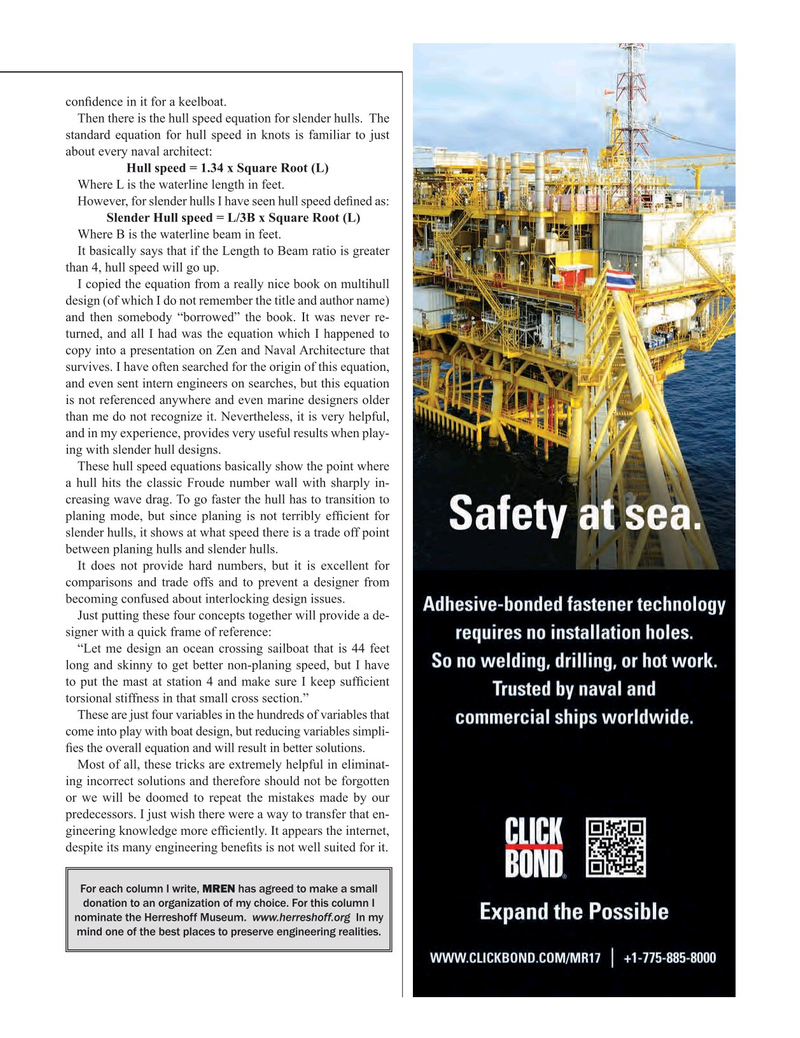
Page 13: of Maritime Reporter Magazine (August 2023)
Shipyard Annual
Read this page in Pdf, Flash or Html5 edition of August 2023 Maritime Reporter Magazine
con? dence in it for a keelboat.
Then there is the hull speed equation for slender hulls. The standard equation for hull speed in knots is familiar to just about every naval architect:
Hull speed = 1.34 x Square Root (L)
Where L is the waterline length in feet.
However, for slender hulls I have seen hull speed de? ned as:
Slender Hull speed = L/3B x Square Root (L)
Where B is the waterline beam in feet.
It basically says that if the Length to Beam ratio is greater than 4, hull speed will go up.
I copied the equation from a really nice book on multihull design (of which I do not remember the title and author name) and then somebody “borrowed” the book. It was never re- turned, and all I had was the equation which I happened to copy into a presentation on Zen and Naval Architecture that survives. I have often searched for the origin of this equation, and even sent intern engineers on searches, but this equation is not referenced anywhere and even marine designers older than me do not recognize it. Nevertheless, it is very helpful, and in my experience, provides very useful results when play- ing with slender hull designs.
These hull speed equations basically show the point where a hull hits the classic Froude number wall with sharply in- creasing wave drag. To go faster the hull has to transition to planing mode, but since planing is not terribly ef? cient for slender hulls, it shows at what speed there is a trade off point between planing hulls and slender hulls.
It does not provide hard numbers, but it is excellent for comparisons and trade offs and to prevent a designer from becoming confused about interlocking design issues.
Just putting these four concepts together will provide a de- signer with a quick frame of reference: “Let me design an ocean crossing sailboat that is 44 feet long and skinny to get better non-planing speed, but I have to put the mast at station 4 and make sure I keep suf? cient torsional stiffness in that small cross section.”
These are just four variables in the hundreds of variables that come into play with boat design, but reducing variables simpli- ? es the overall equation and will result in better solutions.
Most of all, these tricks are extremely helpful in eliminat- ing incorrect solutions and therefore should not be forgotten or we will be doomed to repeat the mistakes made by our predecessors. I just wish there were a way to transfer that en- gineering knowledge more ef? ciently. It appears the internet, despite its many engineering bene? ts is not well suited for it.
For each column I write, MREN has agreed to make a small donation to an organization of my choice. For this column I nominate the Herreshoff Museum. www.herreshoff.org In my mind one of the best places to preserve engineering realities.
MR #8 (1-17).indd 13 8/3/2023 1:10:11 PM

 12
12

 14
14
